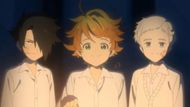When The Promised Neverland first hit screens in 2019, fans hailed it as the next big thing in anime. But then came Season 2. What should have been a dark and emotional journey into the demon world became one of anime’s most infamous speedruns.
The anime compressed over 15 manga volumes into just 11 episodes, cutting out entire arcs, fan-favorite characters, and major emotional payoffs.
So what did happen at the end of The Promised Neverland? Let’s break down both the manga’s full story and the anime’s truncated finale, then look at why things went so wrong.
The manga’s ending: Emma’s promise and the true cost

The manga goes far beyond where the anime stopped. After escaping Grace Field and surviving several close calls, Emma, Ray, Norman, and the other children build alliances, fight demons, and try to uncover the truth behind the “promise” that separates the human and demon worlds.
1. The Goldy Pond Arc
One of the biggest losses in the anime adaptation was the Goldy Pond arc. In the manga, Emma is captured and brought to a secret hunting ground where wealthy demons hunt children for sport. Here, she meets Yugo, a former runaway who becomes a mentor figure, and faces brutal battles against demons like Lord Lewis.
Emma nearly dies, suffers major losses, and truly begins to understand the cruelty of the demon world. This arc is often cited as the peak of The Promised Neverland, and it was completely skipped in the anime.
2. Norman’s return and the moral divide
In the manga, Norman eventually returns, revealed to have been experimented on by the Lambda project. He’s brilliant, but scarred, and now determined to wipe out all demons by poisoning their food supply. For him, the only way to secure humanity’s survival is through genocide.
Emma disagrees. She argues that demons are living beings with families, communities, and the right to exist. This moral conflict between Norman’s utilitarian cruelty and Emma’s idealism drives the latter half of the story.
3. The Queen, Mujika, and the Demon War
The climax of the manga involves Norman launching an all-out assault on the demon capital, aiming to destroy the royal family and end the farm system. Emma and Ray race to stop him, while Mujika - the “Evil-Blooded Girl” who can prevent demons from degenerating- becomes a symbol of coexistence.
The battles are brutal, with the demon queen herself transforming into a monstrous final boss before eventually collapsing under her own hunger for power. Emma convinces Norman to stand down, not through violence, but through sheer willpower and compassion, classic “talk-no-jutsu” style.
4. The final promise
Emma eventually finds the Seven Walls and makes a new promise with the mysterious demon god who maintains the balance between the worlds. Her wish: send all the children to the human world and end the cycle of farms forever.
But there’s a cost. Emma must sacrifice her memories of her family.
5. The bittersweet conclusion
In the final chapters of The Promised Neverland, the children are safely transported to the human world, but Emma is gone. She wakes up in a tiny village with no recollection of her past. Years later, her family finds her.
Though Emma doesn’t remember them, she feels an instinctive warmth and decides to stay with them, ending the series on a bittersweet note: reunited, but not the same.
The Anime’s ending: The speedrun edition

Now let’s talk about Season 2. The anime initially followed the manga faithfully through the Grace Field escape and the forest survival arc. But once the kids reached the shelter, the adaptation took a sharp turn.
What was cut?
- Yugo’s entire story (mentor figure and fan favorite, gone)
- Goldy Pond Hunting Grounds arc (arguably the best arc of the manga)
- Demon politics, royal family, and queen battle (all skipped)
- Norman’s slow return, moral conflict, and Lambda backstory (rushed into a single reveal)
- The Seven Walls exploration and Emma’s deal with the demon god (reduced to vague flashbacks)
Instead, the anime of The Promised Neverland chose to rush straight to the ending. Emma suddenly proposes a “new promise” with almost no setup, and the kids find themselves leaving for the human world after a slideshow-style montage that glosses over multiple arcs.
The “Happy Ending”
Unlike The Promised Neverland manga, the anime gives Emma a cost-free happy ending. She keeps her memories, the kids arrive in the human world, and everything is neatly tied up in just 11 episodes. The anime erased the bittersweet tone of the manga and replaced it with a shallow, convenient resolution.
The production problem

Reports suggest that the anime’s production committee wanted to end the story quickly, since the manga of The Promised Neverland had already concluded, and popularity was fading. Instead of greenlighting a full adaptation, they crammed 15 volumes into a single cour.
The result? A disaster fans compare to Tokyo Ghoul √A or X-Arm - a once-promising adaptation ruined by executive decisions.
Which Ending of The Promised Neverland Was Better?
This is where fans remain split.
- Manga ending: Flawed, rushed, but thematically consistent. Emma’s sacrifice, while divisive, reinforced the central theme of paying a heavy price for freedom.
- Anime ending: Clean, happy, and safe, but hollow. It stripped away the tension, moral ambiguity, and tragedy that made The Promised Neverland special in the first place.
Most fans agree that Season 1 of The Promised Neverland remains the only truly great part of the anime. Everything afterward is better experienced in the manga, even with its flawed finale.
